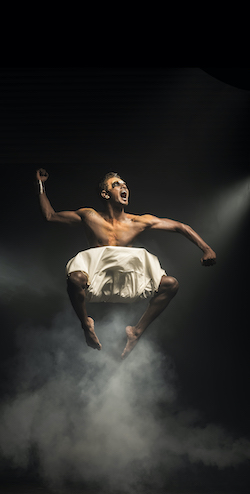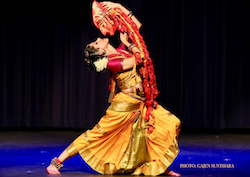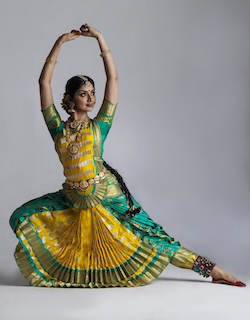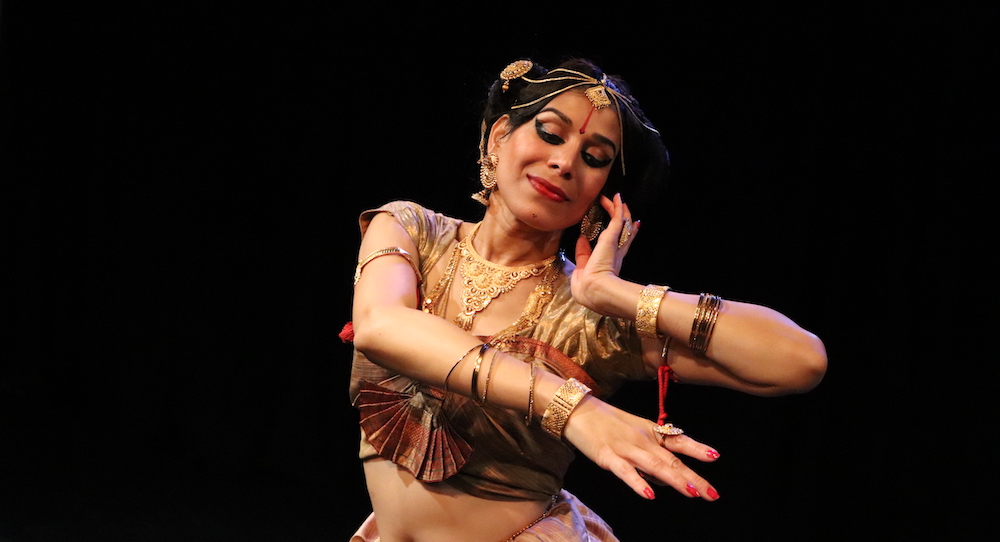September 21-27, 2020.
Streaming on YouTube.
As a dance writer and someone deeply steeped in many different dance sub-communities, I hear about a lot of performances. I can’t see them all. Yet, sometimes a performance promotion catches my eye — in a social media post, an email I almost didn’t read or a mention from a friend. Even if I feel too busy to attend (or these days, view it via film), I make it work to experience the performance. I’m almost always so glad I did. It almost always reminds me that there is no shortage of wonderful art out there, the product of imaginative and devoted people putting themselves out there in the world. It’s like finding a treasure in an expected place every time.
The Indo-American Art Council’s 2020 Erasing Borders Festival was exactly all of that for me. It features classical and contemporary Indian dance artists every year, and this year’s festival naturally had to be virtual. On so many levels, it felt to me like the festival did erase borders — borders on my own typical interests as a dance enthusiast, borders on ways we typically take in this festival and others, cultural borders through exposure to the art of another culture, and much more.
Vishwakiran Nambi’s contemporary work Pyre was the first work of the festival that I viewed. In the film shown before the film of the work, narrating over film of him dancing, he discusses how the experience his art creates for viewers is much more important to him than any particular meaning that they may take away. The mystery and aesthetic confluence of this work’s beginning attests to that interest and perspective. Resonant tones ring through as dancers slowly walk on stage — entwined in unusual ways, supporting other dancers and being supported by them. Once in formation, movement quality and timing takes a 180 degree shift to frenetic and fast.

This tension between different timing and qualities is prevalent in much of the work. Along with the dancers’ facility, evocative lighting, and enticing rhythms of the score, it does bring me into that experience. In a deeper way, it’s an embodiment of experience itself, life being a journey on countless spectrums between opposites.
Another prevalent tension in the work that I can see in the work is that between the individual and the collective, and individuals in the collective support (or don’t support) one another and the collective itself. Much of the time, dancers move in unison — gestural, grounded but also with upward lift, and incredibly rhythmic. Simple stepping and more complex gesture even creates an aesthetic harmony that’s almost trance-like. At other times, partnering and solo work — through shapes and manipulations of physical laws that I don’t think I’ve ever seen before — speaks to actions of overpowering others, supporting others and deliberately standing in opposition to the powerful current of the larger group.
The dancers step in unison rhythm toward upstage, and the lights and music fade down until the piece concludes. Following that is another short film that shares more context around the work, through short interviews of the dancers and Nambi. The choreographer explains the meaning of the title, as a reference to the spiritual practice of walking across hot coals. He is fascinated with the idea of people going through incredible struggle for the promise of a better life or a dream, he explains, and his own struggles and those of his dancers toward what they seek was creative fodder for the piece.
The dancers’ experiences and reflections are also intriguing to hear — such as the rhythmic nature of the work having parallels to Bharatanatym, adjusting to the uniqueness of that style and adding their own influences through the creative process, and the ways working on the piece became legitimately life-changing for them. On the other hand, this high level of contextualization does seem to stand in tension with the idea of emphasizing audience experience over meaning — and, in general, I always feel like there’s something to be said for leaving enough unknown for audience members to come away with their own very personal meaning and experience of the work. Nevertheless, on an intellectual and experiential level, it is highly enjoyable for me to hear the voices of these artists and about the compelling creative process behind Pyre.
Next, I watch a Bharatanatym work danced by Mesma Belsare and choreographed by Maya Kulkarni. Onstage and spotlit, Belsare begins crouched, low in space, moving slowly and thoughtfully. Her classical costume of gold and red — bracelets, ankle bells, hair dressings — give her a regal feeling. Classical Indian instrumental music accompanies her — offering energy, joyfulness and emotional depth through its tonal range. Gesture, physical positioning and facial expression seem to be telling a story. I don’t speak the physical language of this ancient dance form, and as I watch her, I want to be able to. Yet, she is clearly telling a story and is quite evidently captivated in the storytelling as a performer, which is always enjoyable to experience.

Motions such as circling her arms horizontally, as if stirring a dish cooking on a stove, convey domesticity. To end, she reaches up — arms in a “v”, gaze to the sky — and we see her stomach move with the quickened breath of her physical work. I love those moments when dancers find stillness after exerting themselves, and we see their breath working hard; the way they’ve invested their body and spirit in the work is so beautifully clear in those moments.
Reaching big, she takes up space just as she does oxygen — strong and proud in her presence. Whatever might have happened in this story, that is meaning enough for me. In the post-show discussion, both Belsare and Kulkarni discuss how in dance, their interests in music, movement and visual art came together. This love of dance as a confluence of sensory gifts is quite apparent in the dynamic, satisfying work. Kulkarni also discusses the difference between merely narrating through dance and truly embodying the story through expression and physical commitment. Belsare exemplifies the latter — a key part of why the work captivated me, I do think.
Finally, I watch It’s a New Beginning, with choreography and concept from Divyaa Unni and vocal/music from Bhagyalakshmi Guruvayur. It’s a lovely union of movement and music in memorable outdoor spaces. Unni’s classical gestures and footwork are precise but not rigid. Guruvayur’s vocals are just as assured and dynamic. The energy is upbeat and joyful as she tells a story through movement, a beautiful part of Bharantanym as an art form.
Part of me does want to know the story itself, but there is something to be said for the art form being presented in its truest, most authentic form — and who I am I to ask for anything else. The energy does shift at one point, to something slower and more contemplative. Her gestures become more indicative of common actions: eating, cooking, greeting someone. This change does makes the action of the narrative less opaque for me.

The next shift involves her moving to increasingly modernized, increasingly human-influenced locations — a park with pruned trees, in the back of a building with parking signs, and finally an urban street corner where she hears gunshots. At that, she crouches in fear. In front of a wooden fence, she dances with ferocity and intense focus; the effect of what she’s heard and seen seems to have gone deep into her bones and sinew.
She returns to the riverside where she started, seemingly relieved and joyful to be back in safe connection with nature. The last portion of the film has her dancing — with clear intention and passion — in a wide open field, skyscrapers in the background. She seems to have found some sort of balance between the raw natural and man-made. The lighting and quiet peacefulness of the space evokes a newly-found harmony.
To end, her hands come to her heart and she crouches low. “Shanti, shanti, shanti,” sings Guruvayur — “peace, peace, peace.” Unni and her accompanying artists seem to be offering a prayer for the human race — for “a new beginning” where, following COVID, we build back a world that’s better for all of us. I am left thoughtful, touched emotionally and inspired to move — move my own body and move for a better world. Such treasures can be found in unexpected places, so keep your eyes open. You won’t regret it.
By Kathryn Boland of Dance Informa.















